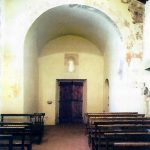The rural settlement, already existing in the Middle Ages along the road leading from Ponte Romito, saw a demographic increase during the 15th century.
The first historical mention of its church dates back to 1198, dedicated to Saint Peter, likely not Saint Peter the Apostle, but Saint Peter Martyr, a Dominican friar and exorcist martyred under Emperor Diocletian, who was often venerated alongside Saint Marcellinus in the medieval period. At that time, the locality was called Soppioro (from the Roman family name of the gens Seppia: vicus Seppiorum, meaning rural settlement of the Seppi).
It seems unlikely that the rededication of the sacred building to Saint Peter Martyr (a Dominican friar who died in 1252) occurred in the second half of the 13th century, but rather in a later period. During the first half of the 14th century (or perhaps even earlier), this church came under the control of the powerful Abbey of Santa Maria d’Agnano, a Benedictine monastery founded by the Ubertini family, which owned numerous properties in the region.
The building, a dependent church of the Laterina parish, featured a single nave made of robust stone blocks (large portions of filaretto masonry are still visible along the northern and southern walls). On the south side, an architraved door led to the spedaletto—a small hospice for travelers or pilgrims, equipped with a ground-level refectory and an upper-floor dormitory.
During the second half of the 15th century, coinciding with the demographic and economic growth mentioned earlier (and perhaps related to the toponym Casanuova), the apse was rebuilt, oriented eastward according to customary practice (the original apse was likely semicircular in shape).
The presbyterial area, with a rectangular plan and covered by a barrel vault, features a narrow single window (monofora), which is adorned externally with simple symbols carved in bas-relief: a face (which, contrary to local tradition, does not represent the head of Saint Peter Martyr), a cross, and a flower or lily. The entire presbytery and the corresponding arch were decorated with frescoes; at the top, the coat of arms of the commissioners was prominently displayed.
In 1941, the 18th-century balustrade from the church of Sant’Agata in Campogialli was brought to this church. The balustrade’s terminal pilasters are carved with two cardinal’s coats of arms. This balustrade was reused during the radical renovation of the sacred building in 1952, when the church’s layout was reversed: the original presbyteral area became the entrance, while a semicircular apse was created at the former façade. In this new apse, two 20th-century stained-glass windows were installed, originally from the old church of Ponticino. These windows depict Saint Domenico Savio and Saint Maria Goretti.
A late 17th-century painting depicting the Madonna with Child, the prophet Isaiah, and Saint Peter Martyr is part of the collection. The original hospital’s rooms, along with the cellars and caves once used for grain storage, were transformed into a small museum of rural civilization following renovations in 1986. The museum features a large collection of objects from daily life in past times, and it also houses a mechanical nativity scene (presepio).




